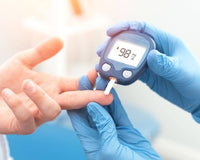Fenofibrate Side Effects, Dosage, Uses, And Warnings
Fenofibrate is a fibric acid derivative used to lower levels of low-density lipoprotein cholesterol and fat in the blood. It works by activating a natural enzyme known as lipoprotein lipase to control fat levels in the blood. In this article we discuss the uses, commonly asked questions, and dosage of fenofibrate.
What Is Fenofibrate?
Fenofibrate is a drug used to help lower levels of bad cholesterol in the blood. It belongs to the class of drugs called fibric acid derivatives.
Uses Of Fenofibrate
Fenofibrate is used in conjunction with a healthy diet to lower levels of LDL cholesterol and fats in the blood and raise levels of HDL cholesterol. Fenofibrate is used to improve cholesterol levels associated with three different cholesterol problems: mixed dyslipidemia, severe hypertriglyceridemia, and primary hypercholesterolemia.
Fenofibrate Brand Name
Fenofibrate can be purchased as both a brand name drug and generic drug. The brand name drugs of fenofibrate include Fenoglide, Triglide, and Tricor.
How Does Fenofibrate Work?
Fenofibrate works by activating a natural enzyme known as lipoprotein lipase which breaks down fats and cholesterol in the bloodstream. Deposits of fat and cholesterol along the walls of arteries can decrease blood flow and oxygen supply to different parts of the body. This can increase the risk of heart disease, stroke, and heart attack.
Fenofibrate Dosage
The dosage for fenofibrate can depend on a variety of factors including age, weight, severity of disease, and brand of fenofibrate. Before taking fenofibrate, patients should first be placed on an appropriate lipid-lowering diet and continue this diet while taking fenofibrate. The recommended dosage for fenofibrate ranges from 50mg to 150mg for severe hypertriglyceridemia. For primary hypercholesterolemia and mixed dyslipidemia, the recommended dosage is 150mg once daily.
Fenofibrate comes as an oral tablet or oral capsule. As a tablet, fenofibrate is available at strengths of 54mg and 160mg. Fenofibrate is also available as a 150mg capsule.
Fenofibrate Side Effects
Fenofibrate does have some potential side effects–some more common and serious than others.
Common Side Effects
Common side effects of fenofibrate include:
- Headache
- Back pain
- Nausea
- Indigestion
- Stuffy or runny nose
- Stomach pain
Serious Side Effects
Serious side effects of fenofibrate may include:
- Yellowing of skin
- Pain in the abdomen
- Dark-colored urine
- Decreased appetite
- Unusual weakness
- Swelling of the face, eyes, lips, tongue, hands, arms, ankles, or feet
- Rash
- Trouble breathing
- Trouble swallowing
- Blistering or peeling skin
Disclaimer: Here at Manifest Pharmacy, our goal is to provide you with the most relevant and current information. However, because drugs affect each person differently, we cannot guarantee that this information includes all possible side effects. This information is not a substitute for medical advice. Always discuss possible side effects with a healthcare professional who knows your medical history.
Warnings Of Fenofibrate
Fenofibrate can cause breakdown of muscle tissue, which can lead to kidney failure. Contact your doctor immediately if you experience any of the following symptoms.
- Muscle pain
- Muscle tenderness
- Fever
- Unusual tiredness
- Dark urine
Fenofibrate Interactions
Fenofibrate is known to interact with blood thinners such as warfarin. Take warfarin at the same time as fenofibrate can cause blood to become dangerously thin.
Fenofibrate is similar to fenobric acid. Do not take medications containing fenobric acid while you take fenofibrate.
Fenofibrate: Side Effects, Dosage, Uses and Warnings Summary
Fenofibrate is a fibric acid derivative used to lower levels of low-density lipoprotein cholesterol and fat in the blood.
It works by activating a natural enzyme known as lipoprotein lipase to control fat levels in the blood. Fenofibrate can be taken as an oral tablet or oral capsule.








